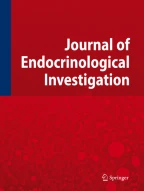Abstract
A series of 35 patients with non-functioning pituitary adenomas undergoing transsphenoidal surgery is presented. In most cases, the presenting symptoms were related to the mass effect of the tumor. There was no operative mortality. Before surgery, visual field defects were documented in 21 patients (60%). After surgery, excluding 3 patients with preoperative blindness, 28% regained normal vision and 67% showed variable improvement. Preoperatively, 24 patients (69%) had abnormal pituitary function, 24 (69%) had hypogonadism, 7 (20%) adrenal insufficiency, 8 (23%) hypothyroidism and 2 (6%) panhypopituitarism. After pituitary surgery, all but one patient with normal preoperative function retained it. Of the patients with hypopituitarism, 11 (46%) had variable improvement and 13 (54%) had persistent deficits. After surgery, 4 patients (57%) with adrenal insufficiency recovered normal adrenal function, 7 patients (29%) with hypogonadism recovered gonadal function and 1 patient (13%) with hypothyroidism recovered thyroid function. Prior to surgery, the presence of a normal or slightly elevated PRL and a rise in TSH after TRH and in LH after GnRH stimulation were of value in predicting possible recovery of pituitary function after surgery. These observations suggest the presence of viable pituitary tissue in these cases and point out that, in some instances, the mechanism of hypopituitarism may be compression of the portal circulation, rather than destruction of the normal pituitary gland.
Similar content being viewed by others
References
Ebersold M.J., Quast L.M., Laws E.R., Scheithauer B., Randall R.V. Long term results in transsphenoidal removal of nonfunctioning pituitary adenomas. J. Neurosurg. 64: 713, 1986.
Klibansky A. Nonsecreting pituitary tumors. Endocrinol. Metab. Clin. North. Am. 16: 793, 1987.
Tucker H.S.G. Jr., Grubb S.R., Wigand J.P., Watlington C.O., Blackard W.G., Becker D.P. The treatment of acromegaly by transsphenoidal surgery. Arch. Intern. Med. 140: 795, 1980.
Ciric I., Mikhael M., Stafford T., Lawson L., Garces R. Transsphenoidal microsurgery of pituitary macroadenomas with long-term follow-up results. J. Neurosurg. 59: 395, 1983.
Cohen A.R., Cooper P.R., Kupersmith M.J., Flamm E.S., Ransohoff J. Visual recovery after transsphenoidal removal of pituitary adenomas. Neurosurgery 17: 446, 1985.
Harris P.E., Afshar F., Coates P., Doniach I., Wass J.A., Besser G.M., Grossman A. The effects of transsphenoidal surgery on endocrine function and visual fields in patients with functionless pituitary tumours. Q.J. Med. 71: 417, 1989.
Atkinson R.L., Becker D.P., Martins A.N., Schaaf M., Dimond R.C., Wartofsky L., Earll J.M. Acromegaly: treatment by transsphenoidal microsurgery. JAMA 233: 1279, 1975.
McLanahan C.S., Christy J.H., Tindali G.T. Anterior pituitary function, before and after transsphenoidal microsurgical resection of pituitary tumors. Neurosurgery 3: 142, 1978.
Nelson A.T., St. George Tucker H. Jr., Becker D.P. Residual anterior pituitary function following transsphenoidal resection of pituitary macroadenomas. J. Neurosurg. 67: 577, 1984.
Post K.D., Biller B.J., Adelman L.S., Molitch M.E., Wolpert S.M., Reichlin S. Selective transsphenoidal adenomectomy in women with galactorrhea-amenorrhea. JAMA 242: 158, 1979.
Arafah B.M., Brookey J.S., Manni A., Velasco M.E., Kaufman B., Pearson O.H. Recovery of pituitary function following surgical removal of large nonfunctioning pituitary adenomas. Clin. Endocrinol. (Oxf.) 17: 213, 1982.
Arafah B.M. Reversible hypopituitarism in patients with large nonfunctioning pituitary adenomas. J. Clin. Endocrinol. Metab. 62: 1173, 1986.
García-Uría J., del Pozo J.M., Bravo G. Functional treatment of acromegaly by transsphenoidal microsurgery. J. Neurosurg. 49: 36, 1978.
Bynke O., Hillman J. Role of transsphenoidal operation in the management of pituitary adenomas with suprasellar extension. Acta Neurochir. (Wien) 100: 50, 1989.
Faria M.A. Tindall G.T. Transsphenoidal microsurgery for prolactin secreting pituitary adenomas. Results in 100 women with the amenorrhea-galactorrhea syndrome. J. Neurosurg. 56: 33, 1982.
Guiot G. Transsphenoidal approach in surgical treatment of pituitary adenomas: general principles and indications in nonfunctioning adenomas. In: Kohler P.O., Ross G.T. (Eds.), Diagnosis and treatment of pituitary tumors. American Elsevier, New York, 1973, p. 159.
Laws E.R., Piepgras D.G., Randall R.V., Abboud C.F. Neurosurgical management of acromegaly. Results in 82 patients, treated between 1972–1977. J. Neurosurg. 50: 454, 1979.
Baskin D.S., Boggan J.E., Wilson C.B. Transsphenoidal microsurgical removal of growth hormone-secreting pituitary adenomas. A review of 137 cases. J. Neurosurg. 56: 634, 1982.
Hout W.M., Arafah B.M., Salazar R., Selman W. Evaluation of the hypothalamic pituitary-adrenal axis immediately after pituitary adenectomy: is perioperative steroid therapy necessary? J. Clin. Endocrinol. Metab. 66: 1208, 1988.
Pont A., Shelton E., Odell W.D., Wilson C.B. Prolactin secreting tumors in men. Surgical cure. Ann. Intern. Med. 91: 211, 1979.
Arafah B.M., Harrington J.F., Madhoun Z.T., Selman W.R. Improvement of pituitary function after surgical decompression for pituitary tumor apoplexy. J. Clin. Endocrinol. Metab. 71: 323, 1990.
Author information
Authors and Affiliations
Rights and permissions
About this article
Cite this article
Marazuela, M., Astigarraga, B., Vicente, A. et al. Recovery of visual and endocrine function following transsphenoidal surgery of large nonfunctioning pituitary adenomas. J Endocrinol Invest 17, 703–707 (1994). https://doi.org/10.1007/BF03347763
Received:
Accepted:
Published:
Issue Date:
DOI: https://doi.org/10.1007/BF03347763
